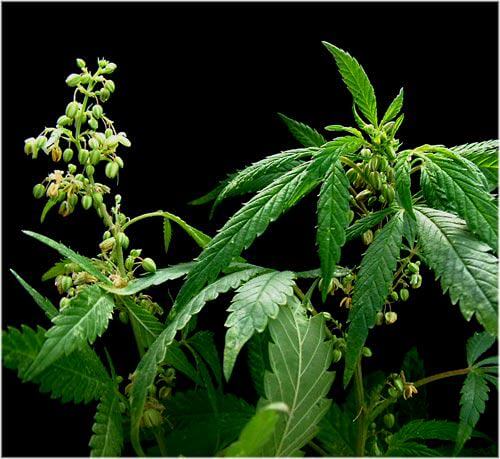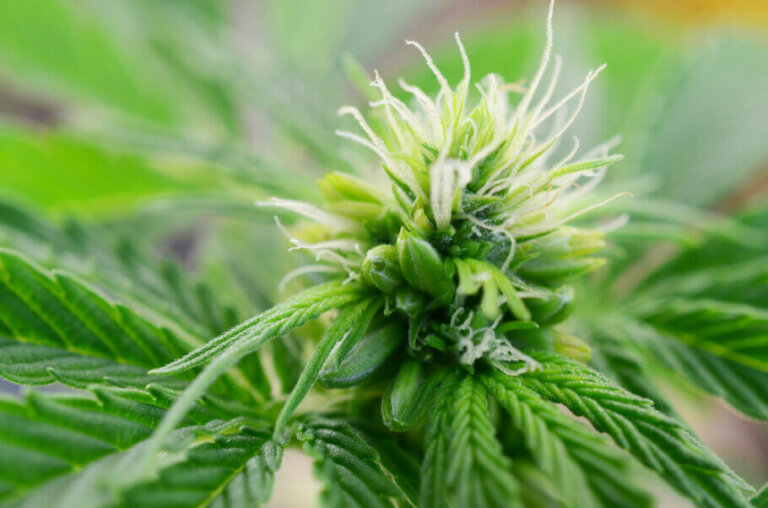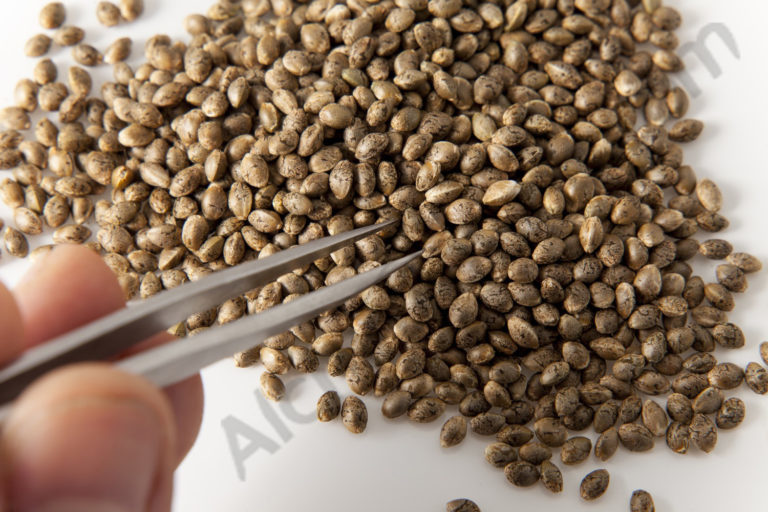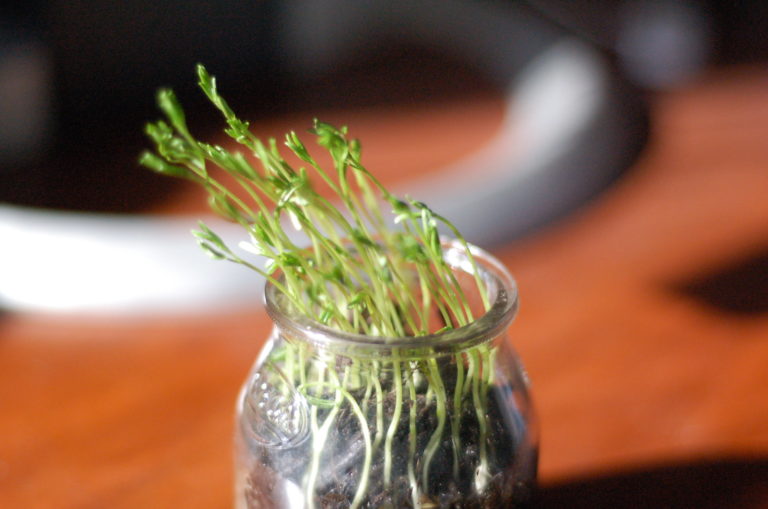Anatomy of the Cannabis plant
List of contents
When it comes to cannabis, the part of the plant that gets all the attention is naturally the bit we're all growing for: the flowers. But while it's easy to be enamoured with the beautiful frosty flowers we shouldn't overlook the rest, because behind the bud there's a whole plant, with all its component parts, each playing an essential role in bringing us our precious harvest.
Here at Alchimiaweb we strongly believe that the more we know about our favourite plants, the more success we'll have cultivating them, and the happier we'll be with the results! For these reasons here we're going to take a closer look at the cannabis plant and identify all the different elements of its anatomy to help you get to know this wonderful plant a little bit better.

The Cannabis seed
For most of us, our introduction to cultivation comes when we buy or are gifted some cannabis seeds for the first time, so let's set out on our examination of cannabis anatomy starting with the seed.
A healthy, mature cannabis seed will be well-rounded in shape with one pointed end and one flat end. They have a tough outer casing that is rigid to the touch, preventing the seed from being easily crushed. A seam separates the two halves of the shell (also known as the hull or pericarp) and is where the seed opens during germination.
Depending on their genetics, seeds can vary greatly in size, from really tiny (800 seeds per gram) to absolutely massive (15 seeds per gram). In mature seeds the outer shell should be covered with attractive dark markings known as "tiger stripes" which, like snowflakes, are unique to each seed and are in reality a thin layer of cells coating the seed and can be rubbed off easily, revealing the true tan/beige colour of the seed beneath.
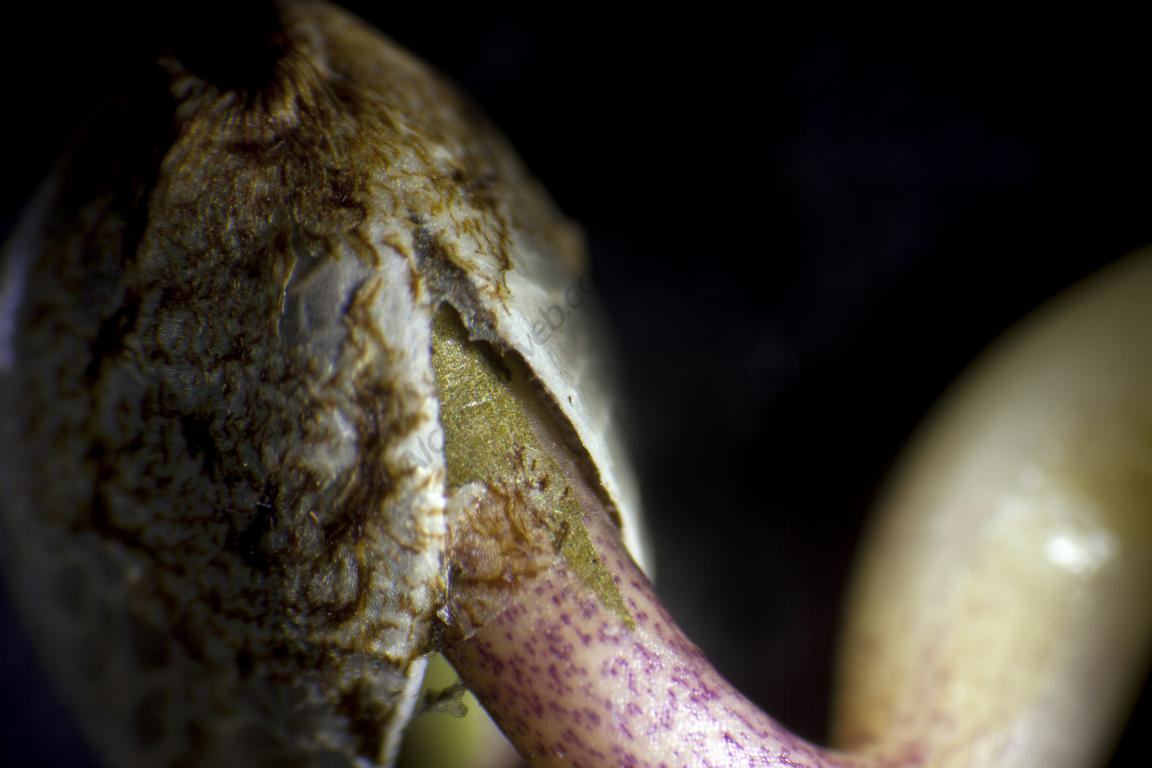
Inside the seed we will find the embryo of the plant, everything needed to start a new life, dormant until the right conditions of moisture and warmth are met. We have the root, or radicle as it's known while still in the seed, the cotyledons, those first, fat, rounded embryonic leaves containing the seed's food reserves for early development. Cannabis is a "dicot" plant, meaning it has two cotyledons. Situated in between the cotyledons, surrounded by the first two true leaves is the apical tip, the point from which the plant will continue growing once germinated.
Roots
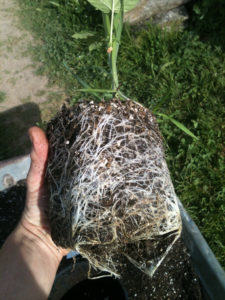
When we germinate a cannabis seed, the first thing that emerges from the opened seed will be the tap root which will begin to grow downwards, seeking out moisture and nutrition and colonising the substrate. The root system has three main purposes, not only does it anchor the plant in the substrate, it provides it with water and the nutrients, and it also acts as storage for sugars and starches produced by photosynthesis. It's hard to overstate the importance of the roots in cannabis cultivation, they really are the foundation upon which everything else is built, without healthy roots we won't harvest beautiful flowers!
Roots themselves can be classified into three types. Firstly the tap root, which is the principal component of the root system, the subterranean counterpart to the plant's main stem, pushing vertically downwards and shooting off branches as it grows. These branches are the second type, the fibrous roots, which branch off from the tap root, extending outwards to form an underground network approximately the same size as the aerial part of the plant. A third type of roots are known as adventitious roots, these are the thick roots that sometimes sprout from the stem just above ground. These are the roots that make it possible to reproduce plants by taking cuttings and cloning them.
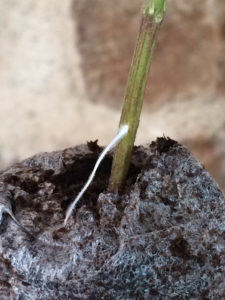
Cannabis plants grown from seed will start life with a tap root system that develops into a fibrous root system, while clones don't have a tap root, starting instead with adventitious roots before developing a fibrous root system. In all cases, a root system needs an adequate balance of moisture and air to be healthy and if care and conditions are right we will be able to see thick, bright white roots with plenty of fine hairs when we transplant.
The root crown
The part of the plant where the roots and stem join is called the root crown, or sometimes collar, or neck. This is a vital part of the plant, the dividing line between upward and downward growth, where the vascular system switches from roots to stem, and one of the places in the plant where most cell division takes place.
The root crown is naturally situated very close to the surface, where aeration is at its most, however some growers will transplant with the crown buried well below the surface, which encourages adventitious roots to sprout from the buried section of stem. It's good way to deal with those leggy seedlings that stretched to get to the light and ended up too tall.
Stem and nodes
The stem of the cannabis plant is the part responsible for keeping the plant upright and for supporting the weight of the plant. It contains the vascular system which works to carry moisture and nutrients from the roots to the leaves via xylem cells, and to transport the sugars and starches produced via photosynthesis around the plant for use or storage via the phloem cells. Phloem is otherwise known as bast, the part of the cannabis or hemp plant that is traditionally harvested for fibre to make rope, canvas etc.
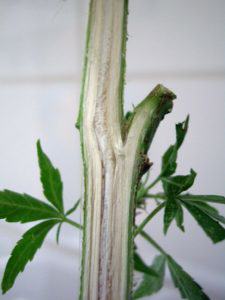
The stem, which can sometimes be hollow, is divided by nodes where the lateral branches begin, with the space between them being known as the internode. Seedlings will begin by growing opposite pairs of nodes and leaves but as time passes the nodes will start to grow alternately, sign the plant is mature and ready to flower.
Taller, stretchier Sativa plants will have a larger internode spacing than squat, compact Indica varieties, although environmental factors can also influence internode space. The nodes are where the first flowers appear (pre-flowers), so it's the first place growers look when trying to determine the sex of plants grown from regular seeds. The small, narrow spear-like leaf growing at each node is called the stipule, and shouldn't be confused with pre-flowers.
Nodes are one of the parts of the cannabis plant where most growth happens and most hormones are produced, for this reason we always cut clones with at least one node to be planted below ground in the substrate, so it can produce auxins (rooting hormones) to begin root development in the undifferentiated meristem cells of the node.
Leaves and petioles
Cannabis leaves are palmately compound (shaped like the open hand, with multiple parts), with anything from 3 to 13 veined, serrated leaflets or fingers. Indica varieties will generally have wider and shorter leaflets of a lush dark green colour, but fewer in number, while Sativas will have longer, narrower leaflets and can be of a lighter green shade. Of course, cannabis is a hugely diverse genus and there are exceptions to this rule, most notably the Ducksfoot variety, with its webbed leaves. Autoflowering varieties will tend to have smaller leaves, with the shape depending on the individual genetics, but as a general rule leaning more to the Indica side.
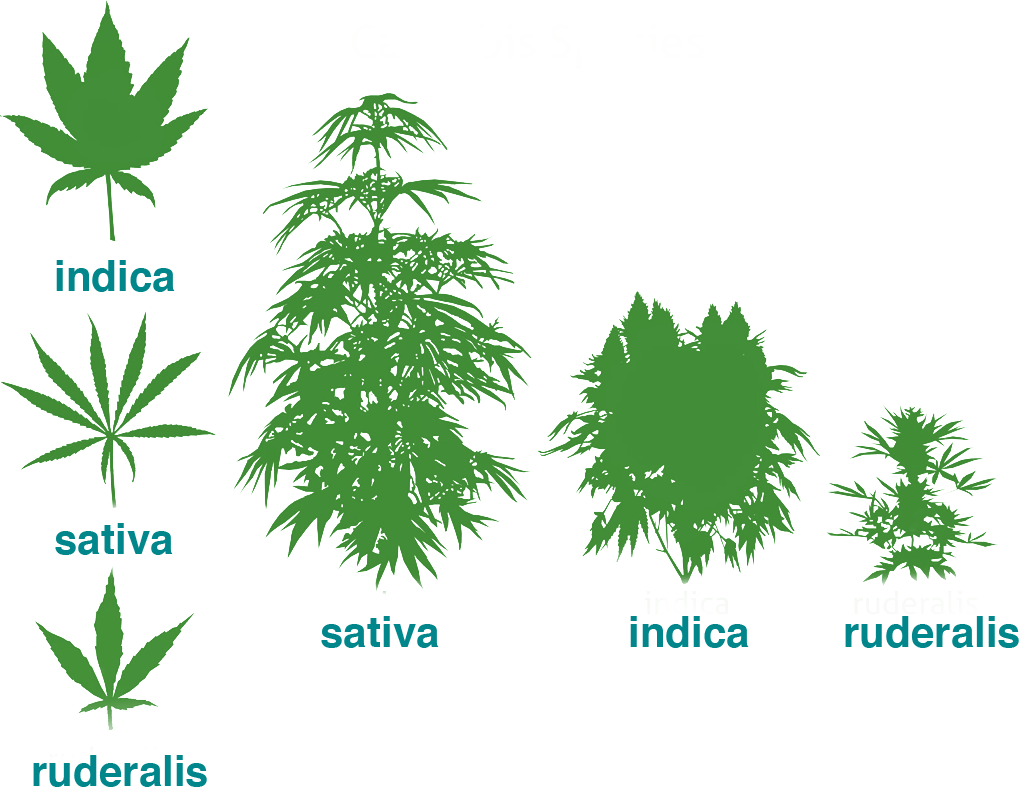
A cannabis plant will have large and small fan-type leaves, which we remove and dispose of at harvest time, and also sugar leaves, which are the small, resin-covered leaves that protrude from the bud. These will either be trimmed away and kept aside for resin extraction, or simply left on the bud and smoked with the flowers.
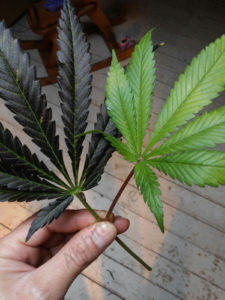
As a seedling grows, each set of leaves has an increasing, odd number of leaflets, so the first set of leaves above the cotyledons will almost always have a single leaflet, the second pair will have three, the third will have five and the fourth will have seven leaflets, and so on until the plant reaches the usual number as dictated by its genetics.
The leaflets join at the point known as the rachis, from where they attach to the stem or branch by a leaf-stem known as the petiole. Petioles can be of varying length depending on the variety and can naturally vary in colour from green to dark purple, although in normally green plants a purple petiole can often be a sign of a phosphorous deficiency.
The fan leaves function both as solar panels and air conditioning for the plants, with the darker green upper side of the leaf producing energy via photosynthesis and the underside regulating internal processes via stomata, tiny pores that absorb the CO2 needed for photosynthesis and at the same time release water and oxygen. The stomata will close at night to conserve moisture and during the day will respond to heat and humidity levels, opening and closing to constantly balance internal moisture levels with external environmental conditions and keep metabolic functions working.
Flowers
Cannabis is dioecious, meaning the male and female reproductive organs are on different plants. Unless we're planning on doing some home breeding and making seeds, we won't be growing any male plants to full maturity, but it's important to be able to identify them, even if we're growing exclusively from feminised seeds, just in case.
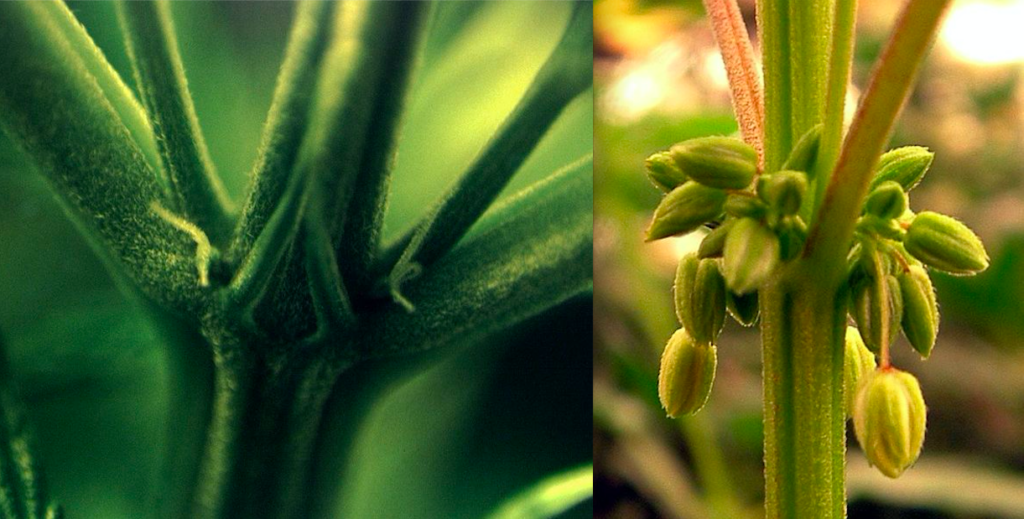
The male, staminate flowers effectively resemble green balls on sticks, composed of five petals which open to reveal five pollen-producing stamens. They grow in long, loose bud clusters from internodes on the branch and once pollen is released the male plants will soon die off. Male flowers contain low levels of cannabinoids and terpenes.
Female pistillate flowers are formed of tight clusters of bracts, the small, teardrop-shaped green petals that we growers refer to as calyxes. Each bract or calyx contains the ovary and the pistillate hair or stigma, which is what growers call the pistil and is the part of the flower that catches airborne pollen. Once pollen lands on the stigma, it is transported down the pollen tube to the ovary where fecundation takes place and the seed is formed, filling and swelling the bract as it grows. The thick, white pistil or hair will shrivel and turn a brown or red colour one it has served its purpose. The seeds are usually mature after a further 4-6 weeks time.
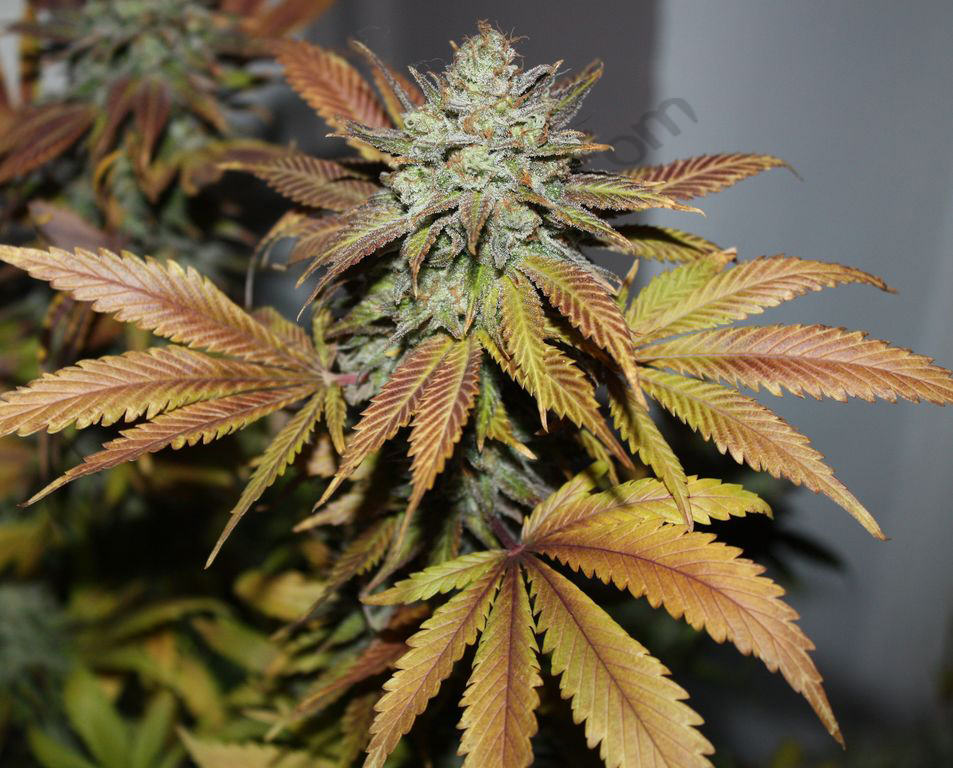
After pollination, female plants will devote their energies towards seed production, at the expense of resin. This means that seeded buds will have lower levels of cannabinoids and terpenes, and is one of the main reasons we strive so hard to grow sinsemilla (seedless) flowers, quite apart from the awful taste of smoking a seed in a joint!
Trichomes
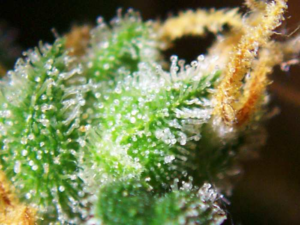
Botanists are still unsure as to exactly why cannabis plants produce such a large quantity of trichomes, but most agree that they most likely have the function of protecting the flowers and developing seeds, whether from harsh UV light, insects, grazing animals or extremes of temperature.
Trichomes have two different basic types: Glandular and non-glandular, with the principal difference being that non-glandular trichomes grow without a trichome head or gland, having the appearance of small hairs and mainly developing on stems, leaves, petioles and to a lesser extent on the flowers themselves, while glandular trichomes are found mainly on the flowers and sugar leaves, and possess the resinous gland where the cannabinoids and terpenes are secreted.
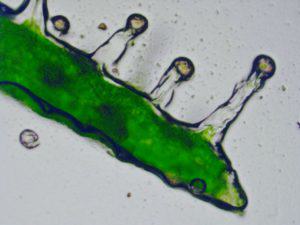
Glandular trichomes are themselves divided into three main kinds, which are: bulbous, the smallest and least numerous; capitate-sessile, which are larger and grow low, close to the leaf surface; and finally capitate-stalked, which are the largest, most numerous trichomes, found in highest concentration on the flowers and those with the greatest cannabinoid content, appearing somewhat like a tall mushroom, with a long stem and a large, rounded head - the iconic image of a trichome.
As the flowers mature, the trichomes will change colour, starting out transparent, passing through a milky-white stage nearing maturity and going on to become amber coloured when fully mature. Different growers will harvest their flowers depending on personal taste and the effect they're looking for, but on our blog you can read a useful guide to harvesting according to trichome ripeness, which will help you to bring your crop down at the optimum moment.
Hopefully after reading this you're now a bit more familiar with the anatomy of the cannabis plant and will become a better grower as a result... Knowledge is power!
Happy growing!
































































